The Technical Requirement for Water Quality Automatic Analyzer of Electroconductivity (HJ/T 97-2003); The Technical Requirement for Water Quality Automatic Analyzer of Turbidity (HJ/T98-2003); Coding Rules of Water Bodies for Surface-water Environment in China (HJ 932-2017); Fundamental Specification of Equipment of Automation System for Hydrological Measurement And Forecast (SL/T102-1995); Specification for Hydrological Data Auto-Acquisition and Transmission System (SL61-2015); Specifications on Lightning Protection for Engineering of Telecommunications (YD5078-1998); Low-Voltage Switchgear and Control Equipment -- General (GB/T14048. 1-2000); Basic Mode Control Procedures for Data Communications (GB/T3453); Application-level Protocol for Real-Time Data Traffic in Electric Power System (DL/T 476-2012); List of Definitions for Interchange Circuits Between Data Terminal Equipment (DTE) and Data Circuit-Terminating Equipment (DCE) (GB/T3454-2011); Data Elements and Interchange Formats-Information Interchange-Representation of Dates and Times (GB/T7408-2005); Mechanical Structures for Electronic Equipment-Outdoor Enclosures (GB/T19183. 5-2003/1EC1969. 3-2001); Environmental Quality Standards for Surface Water (GB 3838-2002); Quality Standards for Surface Water Resources (SL63-1994); Water Quality Analysis Methods (SL78-94T994); Structure and Identifier for Water Quality Database (SL325-2005); Regulation for Water Environmental Monitoring (SL219-2013); Technical Requirements for National Surface Water Quality Automatic Monitoring Station and Water Acquisition (Annex: HBJCH [2017] No. 1762); The Technical Requirement for Water Quality Automatic Analyzer of Total Nitrogen (HJ/T 102-2003); The Technical Requirement for Water Quality Automatic Analyzer of Total Phosphorous (HJ/T 103-2003); The Technical Requirement for Water Quality Automatic Analyzer of Permanganate Index (HJ/T100-2003); The Technical Requirement for Water Quality Automatic Analyzer of Ammonia-Nitrogen (HJ/T 101-2003); The Technical Requirement for Water Quality Automatic Analyzer of PH (HJ/T 96-2003); The Technical Requirement for Water Quality Automatic Analyzer of Dissolved Oxygen (HJ/T 99-2003).
System construction shall not only meet the recent requirements, but also adapt to long-term development. Therefore, in the principle of "unified leadership, unified norms, unified standards and step-by-step implementation", it makes full use of various information sources, dredges information circulation channels and ensures smooth and fast information circulation.

The water quality online automatic monitoring system is a system that integrates analysis instruments for multiple monitoring indicators and covers such parts as sampling, analysis, recording, data sorting (including remote data) and centralized telecontrol. Combined with corresponding monitoring and analysis software, it realizes real-time online automatic monitoring, meets the requirements of reliable and stable operation and low maintenance workload and can be unattended. System construction shall not only meet the recent requirements, but also adapt to long-term development. Therefore, in the principle of "unified leadership, unified norms, unified standards and step-by-step implementation", it makes full use of various information sources, dredges information circulation channels and ensures smooth and fast information circulation.

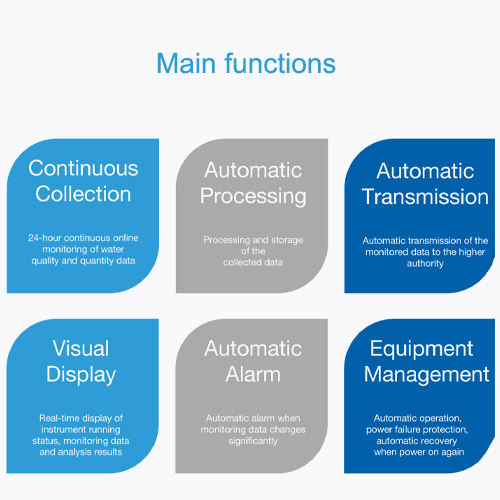
1.The overall design is characterized by practical, advanced, open, safe and economic.
2.The overall design complies with relevant national and industry technical standards and specifications.
3.The accuracy and precision of water quality data must meet the requirements and the monitoring data synchronized with the laboratory must be within the allowable error range.
4.The adopted equipment conforms to the principles of simple structure, reliable performance and low energy consumption, and the system can work for a long time under unattended conditions.
5.The system has good compatibility and scalability. With the future expansion requirements for the instrument fully considered, the relevant equipment reserves corresponding margin and interface.
6.The sampling method is designed reasonably and does not affect the test results of water quality parameters. Stable operation is realized under severe weather conditions.
7.The system has automatic protection and recovery functions for power failure and water failure, and the system itself can maintain operation for 12 hours.
8.The location and cause of the fault can be judged, and automatic alarm is realized in case of faults and abnormal conditions; monitoring frequency can be set.
9.The analysis instrument is automatically calibrated before each monitoring process, and the internal pipeline of the system is back-flushed after monitoring.
10.Remote display of instrument status, remote calibration and remote cleaning can be realized.
11.The output signal of the instrument should adopt 4-20mA or RS232 (RS485) interface for selection; if RS232 interface is adopted, interface protocol should be provided to facilitate data communication with relevant computer network systems.
12.The interface design of the system control software should be concise, beautiful, practical, fully functional, easy to operate and suitable for interpretation by monitoring technicians and leaders. The database has the functions of management, analysis, query and secondary development.
13.Safe disposal of waste liquid discharge avoids the secondary pollution.
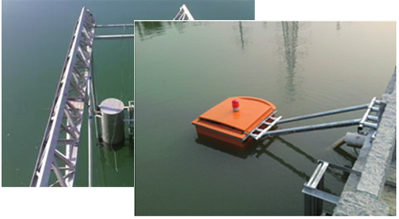
When selecting the location of the online water quality monitoring station, the representativeness of the water quality of the monitoring sections should be considered firstly. Sections with poor water quality representativeness are not considered; where sections have good water quality representativeness, the conditions of such public works water, electricity, communications and traffic for the basic construction of water quality monitoring station should be considered. The difficulty of monitoring sampling works is also one of the key considerations. Different water collection units should be designed according to the width of water surface, sediment, water flow, tide size and whether the shipping is busy, such as trestle, waterside pavilion, cantilever, semi-cantilever and pontoon.
The water collection unit is responsible for completing the collection and delivery of water samples and consists of a pump, pipelines, pressure and flow control valves, a sample pre-filtration system, etc. In any case, it can ensure that the water samples at the collection point are brought into the pretreatment unit, and its water volume and hydraulic pressure should meet the needs of the water distribution system and analytical instruments.
The water sample pretreatment unit is an important part of the entire automatic monitoring system. Due to the complexity of the water body, the quality of the water sample pretreatment directly determines the accuracy of the monitoring value of the analytical instrument. The system can be divided into three pretreatment steps (as shown in the figure on the right).
The water quality online monitoring and analysis unit is responsible for completing the monitoring and analysis of water samples, as well as the collection, storage and uploading of water quality information, including the monitoring and analysis of five general parameters (water temperature, pH, dissolved oxygen, conductivity and turbidity), ammonia-nitrogen, CODMn, total phosphorus and total nitrogen.
The core of the control and data acquisition unit includes: PLC control acquisition unit, on-site IPC and on-site monitoring software. The example of the control and data acquisition unit is shown below:
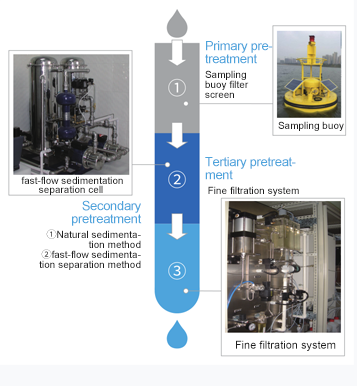
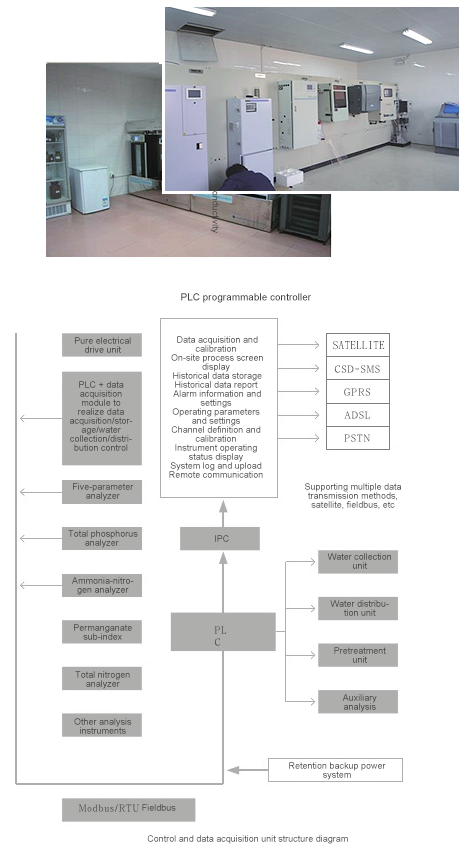
The auxiliary unit is mainly composed of a cleaning and algae removal unit, a compressed air unit and a pure water preparation unit.
1.Cleaning and algae removal unit
The mass propagation of algae in the pipeline can change the parameter index of water samples, and the collected water samples will lose its representativeness in severe cases. The most prominent manifestation is the degradation of ammonia-nitrogen, which makes the measurement result of the ammonia-nitrogen analyzer deviate from the true value. According to the actual use, a variety of cleaning methods can be combined to achieve the best cleaning effect. The combination of multiple cleaning methods like forward and reverse cycle cleaning, forward and reverse pressure oscillation cleaning, forward and reverse heating cycle cleaning and the adjustment of cleaning frequency and cycle can effectively prevent the growth of algae and keep the analysis pipeline clean and make the analysis system always in the best operating state.
2.Compressed air unit
The air source of the air unit is mainly provided by devices such as the air compressor and the decompression filter duplex in the equipment. The air compressor is oil-free type, which ensures that it will not affect the analysis results. It ensures the normal operation of the automatic back-flush cleaning system in the water station.
3.Pure water equipment unit
The tap water system provides water source for the pure water unit. It is necessary to ensure that the tap water system is clean and the pressure can be maintained above 0.2MPA for a long time. It is used for the normal cleaning of the water quality online automatic monitoring system and the preparation of pure water. Continuous supply of the tap water system should be ensured.
The electrical system, pipeline and other devices of the water quality online monitoring station are controlled through a combination of remote control, automatic control and on-site control. All the scenes are controlled by the data terminal combined with the PLC controller. The specific schematic diagram is as follows:

10% spare control points shall be provided on the basis of meeting the on-site control points for future revision and upgrade of control units. It can remotely display on-site working status, safety and parameter exceeding (upper and lower limit) alarms and automatically send alarms and abnormal events to monitoring centers at all levels.Be able to record the handling of abnormal on-site events, instrument repair, calibration, labeling and other maintenance work logs.The measuring station should have effective ID authorization control and illegal use is prohibited.The control system should be able to control some basic functions of the instruments, such as standby control, working mode control, calibration control, cleaning control, water outage protection, etc. Operation mode can be set: Continuous or intermittent operation mode can be set to the system on site or remotely.It can trigger the sampling of the automatic sampling instrument when the water quality exceeds the standard.
Acquisition frequency: X2 times per second per channel
Acquisition accuracy: Better than 1/4000 (more than 12 effective digits)
Data collection error limit: Collection error is better than 0.04% of the full scale
Number of channels: In the case of meeting the existing acquisition channels, there should be no less than 3 spare channels for instrument expansion and emergency channel replacement.
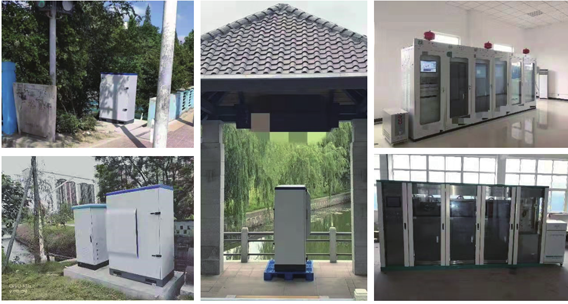
◎ 2Beijing's Surrounding Water Source Monitoring and Protection Project during the 2008 Beijing Olympic Games/p>
◎ Water Quality Monitoring Project for Ximenli Reservoir Water Resources Protection and Construction of Zherong County/p>
◎ Hechuan Water Diversion Project Water Level and Water Quality Monitoring Project of Shanxi Province/p>
◎ Urban Water Resources Real-time Monitoring and Management System Project in Langfang City of Hebei Province/p>
◎ Baishan City Jingyu National Nature Reserve Ecological Monitoring Mineral Water Quality Online Monitoring Project of Jilin Province/p>
◎ Mabian Yi Autonomous County Water Source Water Quality Online Monitoring Project